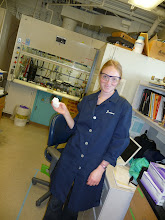Step 1: Dismantle the still. Bring the grimy distillation flask to an open space for the quenching process.

Step 2: Cool isopropanol in a large ice bath and slowly pour in the contents of the distillation flask to the stirred isopropanol. Depending on the volume of liquid/gunk, this may take anywhere from a few hours to a few days if you do it carefully and with respect for the well-being of those around you.

Step 3: Once all the pourable brown sludge has been removed from the distillation flask, add a small amount of THF to remove some residual sludge. Dump that THF solution into the isopropanol solution, which is still stirring but probably more slowly than before due to the presence of solid sludge/funk/gunk. Now the distillation flask is ready to be cleaned! First water, then 1M HCl, and voila:

















